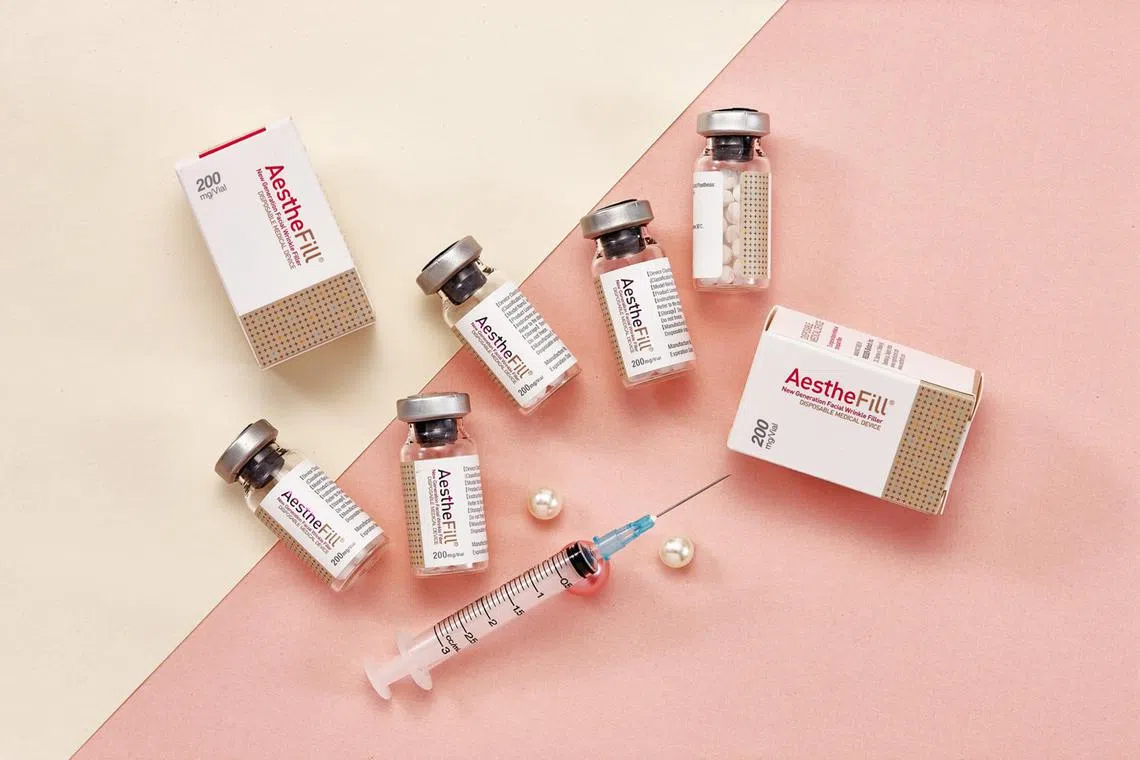MOH probing case of woman losing vision after dermal filler treatment
Sign up now: Get ST's newsletters delivered to your inbox

The dermal filler AestheFill was registered for use in Singapore in October 2021.
PHOTO: REGEN BIOTECH
Follow topic:
SINGAPORE - The accidental injection of a dermal filler into the bloodstream led to a woman losing her vision in the first reported case of its kind in Singapore, the product distributor said, citing the results of its investigations.
Meanwhile, the Ministry of Health (MOH) told The Straits Times late on Friday night that it is investigating a case of blindness resulting from the administration of the dermal filler AestheFill in July. Its spokesperson said that as investigations are under way, the ministry could not give further details.
Shedding more light on the incident first reported by ST on Monday
The woman was injected with AestheFill, a dermal filler from South Korea that temporarily reduces wrinkles and folds in the skin, at a clinic in Redhill on July 20.
According to sources with knowledge of the incident, she is a Singaporean in her 30s.
The Parvus spokesman declined to elaborate further on the incident, citing patient confidentiality.
On Monday, the Health Sciences Authority (HSA) confirmed to ST that it was told of the incident on July 29.
The regulator said it was investigating whether there were batch-related defects that could have affected product safety and quality.
The Singapore Medical Council, meanwhile, said it was monitoring the developments closely and would take appropriate action, if needed, when investigations by MOH and HSA conclude.
The Parvus spokesman recommended that people considering such aesthetic treatment should seek consultations only from medical practitioners who are qualified and have undergone proper training in administering dermal fillers.
“It is crucial to discuss any concerns with your healthcare provider and to fully understand the inherent risks associated with any medical procedure,” he added.
“We are continually investing in training and best practices to ensure that the risks are minimised.”
The clinic where the incident happened has been closed since Tuesday. A representative for the clinic earlier declined comment, citing patient confidentiality.
The clinic did not answer queries on Friday.
Based on ST’s checks, AestheFill continues to be available at clinics, though several have been getting calls from patients asking to cancel or reschedule their AestheFill treatment appointments this week.
Dr Pek Chong Han, a consultant plastic surgeon at Gleneagles Hospital and Camden Medical centre, said the complications he had observed from aesthetic treatments were primarily due to the technique of administration and not the product.
Citing a 2016 medical journal article titled “Prevention and management of vision loss relating to facial filler injections” by a group of experienced Singapore clinicians, including aesthetic doctors and ophthalmologists, he highlighted the elevated risk of blindness during injections close to the eyes, nose and glabella – the area between the eyebrows and above the nose.
All three areas are dense with blood vessels.
For blindness to occur, he said, the product has to inadvertently enter one of the blood vessels.
“When the injection pressure is high, the product will then migrate from where it’s supposed to be. And once the product reaches one of the smaller blood vessels, it blocks it,” said Dr Pek, medical director of Polaris Plastic and Reconstructive Surgery.
Such blockage can lead to ischaemia, a condition where blood flow to the retina is restricted or reduced, causing vision loss, he added.
The tell-tale signs are almost immediate. Patients could feel searing pain in their eyes or experience blanching, where their skin turns pale.
Whether the loss in vision can be reversed would depend on the extent of ischaemia inflicted upon the retina.
In cases of vision loss, swift emergency treatment is imperative, noted Dr Pek.
The 2016 study highlighted that prevention, through a proper understanding of facial anatomy and good injection technique, is key.
The study also recommended immediate measures to take in the event of vision loss after filler injections.
If the practitioner suspects a blood vessel to the retina has been compromised, the injection should be stopped and the patient placed on his or her back.
Drugs, the study noted, need to be administered immediately, followed by massaging the area around the eyes.
For optimal outcomes, this should be done within 60 to 90 minutes from the onset of symptoms.
Meanwhile, reactions from the public have been varied in the aftermath of the incident, with many people and doctors voicing their concerns on social media.
Ms Evonne Ng, 38, a public relations and marketing professional who goes for filler and Botox treatments, said she would not stop her treatments.
She stressed that the doctor’s skills are an important factor when picking a clinic.
“I always advise people to select their doctor carefully,” said Ms Ng, who specialises in the aesthetic industry and used to run an aesthetic clinic.
“All treatments have their risks. Even something as regularly done as Botox can have potential side effects. Consumers should read up and ask all the questions needed before proceeding.”
A 50-year-old housewife, who declined to be named, said she was shocked to read about the incident. But she has no intention of stopping her Botox and collagen booster treatments.
“Because it helps with anti-ageing, and at the moment, I am not ready to age gracefully,” she said.


